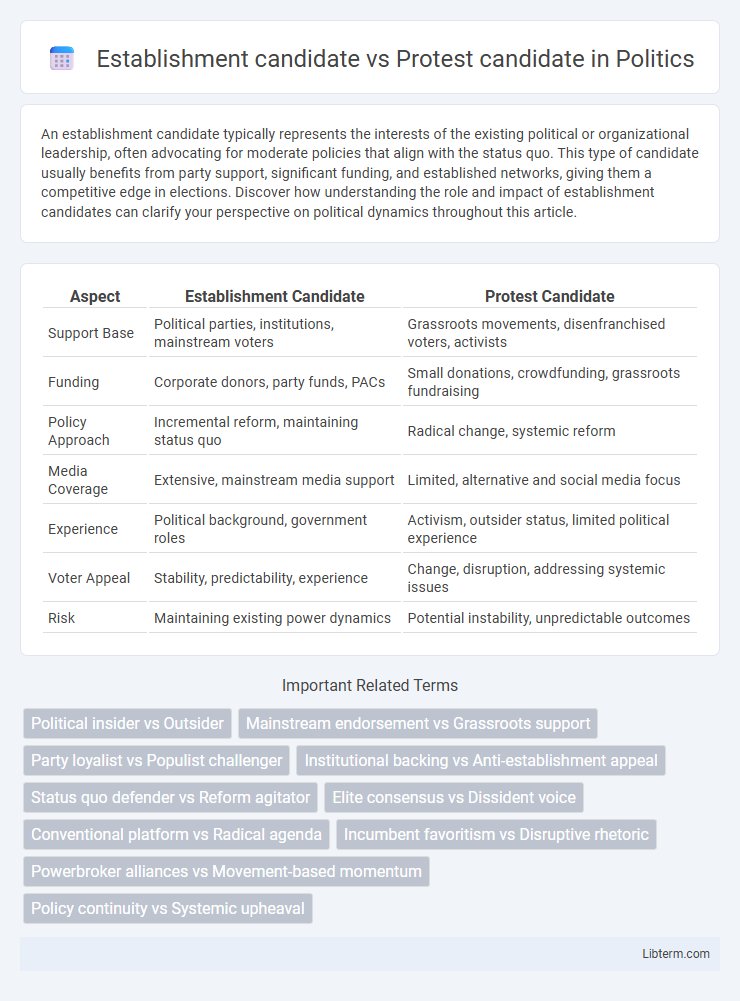An establishment candidate typically represents the interests of the existing political or organizational leadership, often advocating for moderate policies that align with the status quo. This type of candidate usually benefits from party support, significant funding, and established networks, giving them a competitive edge in elections. Discover how understanding the role and impact of establishment candidates can clarify your perspective on political dynamics throughout this article.
Table of Comparison
| Aspect | Establishment Candidate | Protest Candidate |
|---|---|---|
| Support Base | Political parties, institutions, mainstream voters | Grassroots movements, disenfranchised voters, activists |
| Funding | Corporate donors, party funds, PACs | Small donations, crowdfunding, grassroots fundraising |
| Policy Approach | Incremental reform, maintaining status quo | Radical change, systemic reform |
| Media Coverage | Extensive, mainstream media support | Limited, alternative and social media focus |
| Experience | Political background, government roles | Activism, outsider status, limited political experience |
| Voter Appeal | Stability, predictability, experience | Change, disruption, addressing systemic issues |
| Risk | Maintaining existing power dynamics | Potential instability, unpredictable outcomes |
Understanding Establishment vs Protest Candidates
Establishment candidates typically represent mainstream political parties with established support networks, institutional backing, and moderate policy platforms designed to maintain the current system. Protest candidates emerge outside traditional party structures, often advocating radical reforms or anti-establishment positions that challenge prevailing political norms. Understanding the distinction involves analyzing voter bases, campaign strategies, and the broader socio-political context driving demands for change versus stability.
Historical Context of Candidate Types
Establishment candidates typically emerge from dominant political parties with strong institutional backing and a history of governance, reflecting continuity and mainstream policy preferences. Protest candidates arise during periods of political dissatisfaction, representing outsider movements that challenge the status quo and appeal to voters seeking radical change or reform. Historical contexts such as economic crises, social unrest, or perceived government failures often catalyze the rise of protest candidates, reshaping electoral landscapes and party dynamics.
Core Characteristics of Establishment Candidates
Establishment candidates typically possess strong ties to major political parties, extensive experience in government or public office, and well-established fundraising networks, ensuring broad institutional support. They often advocate for moderate policies that appeal to the party base and mainstream voters, prioritizing stability and incremental change. Their campaign strategies leverage traditional media and endorsements from influential figures, emphasizing governance readiness and political pragmatism.
Defining Traits of Protest Candidates
Protest candidates typically emerge from grassroots movements and challenge the policies and legitimacy of establishment parties, often advocating for radical reforms or anti-corruption measures. They embody outsider status, capitalizing on public dissatisfaction, and prioritize issues ignored by mainstream politics, such as social justice or economic inequality. Their campaign styles are marked by populist rhetoric, unconventional tactics, and strong emotional appeals aimed at mobilizing disenfranchised voter segments.
Voter Demographics and Their Preferences
Establishment candidates typically attract older, wealthier, and more moderate voters who prioritize stability, experience, and incremental policy changes. Protest candidates appeal to younger, less affluent, and more ideologically driven individuals seeking radical reforms and challenges to the political status quo. Voter preferences often reflect distinct attitudes toward government trust, economic inequality, and social justice, segmenting support along these demographic and ideological lines.
Media Influence on Candidate Perception
Media influence on candidate perception varies significantly between establishment and protest candidates, as mainstream outlets often provide more favorable coverage to establishment candidates due to their perceived stability and political experience. Protest candidates typically receive polarized media attention, with coverage emphasizing their outsider status and potential for disrupting the status quo, which can mobilize grassroots support but also invite skepticism. The framing and volume of media exposure shape public opinion by reinforcing existing biases or introducing new narratives about each candidate's viability and policy positions.
Policy Differences: Mainstream vs Radical Agendas
Establishment candidates prioritize pragmatic, incremental policy changes aligned with existing institutional frameworks, emphasizing economic stability, moderate social reforms, and foreign policy continuity. Protest candidates advocate for radical agendas that challenge the status quo, promoting sweeping social justice reforms, redistribution of wealth, and systemic political changes aimed at addressing structural inequalities. The divergence between these candidates centers on their approach to governance, with establishment figures favoring gradual adaptation and protest candidates pushing for transformative disruption.
Impact on Party Unity and Identity
Establishment candidates often reinforce party unity by adhering to traditional platforms and appealing to the party's core base, strengthening a consistent party identity. Protest candidates challenge the status quo, attracting dissident voters and potentially causing internal divisions that expose ideological rifts within the party. The dynamic between these candidates shapes the party's cohesion and signals its strategic direction to the electorate.
Election Outcomes: Success Rates and Examples
Establishment candidates typically demonstrate higher success rates in elections due to robust party backing, extensive fundraising networks, and widespread voter recognition, as seen in Joe Biden's 2020 presidential victory. Protest candidates, despite energizing grassroots movements and highlighting systemic issues, often struggle to secure broad electoral support, exemplified by Bernie Sanders' insurgent campaigns in 2016 and 2020 that fell short of the Democratic nomination. Election outcomes frequently favor establishment candidates because institutional resources and party infrastructure heavily influence voter turnout and media coverage.
Future Trends in Candidate Selection
Future trends in candidate selection indicate a growing divide between establishment candidates, who benefit from traditional party support and institutional resources, and protest candidates, who leverage grassroots mobilization and social media influence. Data shows increasing voter engagement with non-establishment figures who address systemic dissatisfaction and emerging social issues. Political parties may adapt by integrating digital platforms and community-driven approaches to balance experience with authenticity in upcoming elections.
Establishment candidate Infographic

 libterm.com
libterm.com